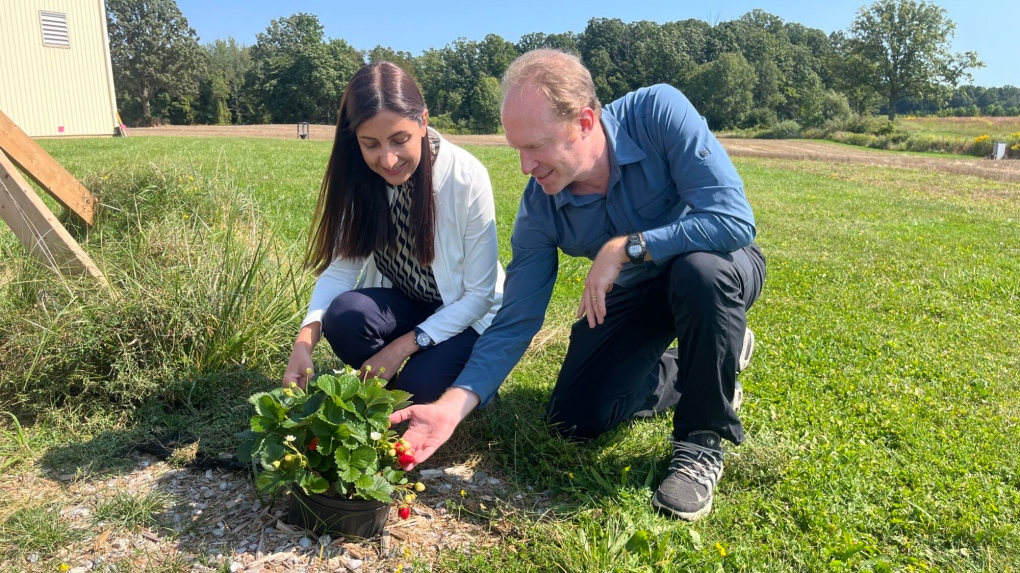New AI model developed at Western detects strawberry diseases, takes aim at waste
 Joshua Pearce and Soodeh Nikan investigate strawberries in the agrivoltaic agrotunnel at the Environmental Sciences Western Field Station (Source: Jeff Renaud/Western Communications)
Joshua Pearce and Soodeh Nikan investigate strawberries in the agrivoltaic agrotunnel at the Environmental Sciences Western Field Station (Source: Jeff Renaud/Western Communications)
Research from Western University could help farmers get out of a jam by using artificial intelligence (AI) and camera monitoring to enhance strawberry cultivation.
A new paper produced by local researchers aims to use machine learning to predict ripeness and detect diseases early.
The hope is that the findings of John M. Thompson Chair in Information Technology and Innovation at Western Engineering Joshua Pearce, electrical and computer engineering professor Soodeh Nikan, and their collaborators will help extend the growing season of strawberries in Canada.
They managed to increase the accuracy of their study by monitoring their strawberries in a controlled environment – using indoor hydroponics, and grow lights.
“We have greatly increased accuracy in detecting different diseases and also sensing the brightness of the strawberries, which is crucial for understanding the quality of the crop and determining the best times to pick,” said Nikan.
Their computer system achieved nearly 99 per cent accuracy in predicting ripeness and classifying diseases.
 Joshua Pearce and Soodeh Nikan investigate strawberries grown under an agrivoltaic installation at the Environmental Sciences Western Field Station (Source: Jeff Renaud/Western Communications)
Joshua Pearce and Soodeh Nikan investigate strawberries grown under an agrivoltaic installation at the Environmental Sciences Western Field Station (Source: Jeff Renaud/Western Communications)
What does this mean for the consumer? The hope is that models like the one produced at Western could help with your grocery bill.
“Reducing waste and the cost of food is obviously a big issue these days. Like everyone, I am always surprised when I go to grocery store and see the price of fresh fruits and vegetables,” said Nikan. “When choosing projects, I usually look for something that is safety critical or a societal need. With my experience in other applications, I jumped at the chance to apply my knowledge and expertise to food security.”
The team worked to make the model free, and easy to apply, with the hope that more farmers will choose to integrate it into their agricultural practice.
“The software is completely free and open-source and farmers of any type are free to download it and then adapt it to their needs,” said Pearce. “They may prefer to have the AI system send them an email or ping their phone when they detect disease or even forward an image of a specific plant that is ready to pick. The software is wide open to make it your own.”
What’s next for the team? They hope to implement their software outdoors in a less controlled environment – possibly using drones to monitor outdoor fields.
One day, a flying robot may just tell a farmer which field is ready when.
CTVNews.ca Top Stories

DEVELOPING Weather warnings issued in 6 provinces and territories
Wintry weather conditions, including heavy snow and wind chill values around -55, prompted warnings in six provinces and territories early Thursday morning.
10 people are wounded in a shooting outside a New York City nightclub
Ten people were wounded in a shooting outside a New York City nightclub while they were waiting to get into a private event, police said.
LIVE UPDATES The Latest: FBI investigating New Year's Day attack in New Orleans that killed at least 15 people
The FBI is investigating an early Wednesday attack in which a U.S. Army veteran drove a pickup truck into a crowd of New Year's revelers in New Orleans, killing 15 people. Here's the latest.
Here's how immigration rules are changing in 2025
Canada's federal government is changing course on immigration with a wave of tighter caps on newcomers and new rules for permanent and non-permanent residents.
Who are Canada's top-earning CEOs and how much do they make?
Canada's 100 highest-paid CEOs earned $13.2 million on average in 2023 from salaries, bonuses and other compensation, according to the Canadian Centre for Policy Alternatives.
Jocelyn Wildenstein, 'Catwoman' socialite known for her extreme cosmetic surgery, dies
Jocelyn Wildenstein, the Swiss-born socialite famous for the surgery-enhanced feline features that earned her nicknames in the American press like 'Catwoman,' has died.
opinion 7 tips to give yourself a financial restart this new year
The start of a new year is the perfect time to take control of your finances and set yourself up for success, says personal finance contributor Christopher Liew in a column for CTVNews.ca.
Canadian government watering down promise to fully scrutinize firearms before sale, group says
A leading gun-control group is accusing the Liberal government of watering down a promise to ensure firearms are properly scrutinized before entering the Canadian market.
North Atlantic right whales should live past 100 years old. They're dying around 22
North Atlantic right whales should live well past 100 years, but threats to the endangered species, including from commercial crab and lobster fishing, have cut their lifespan to a fraction of that, a recent study suggests.

































